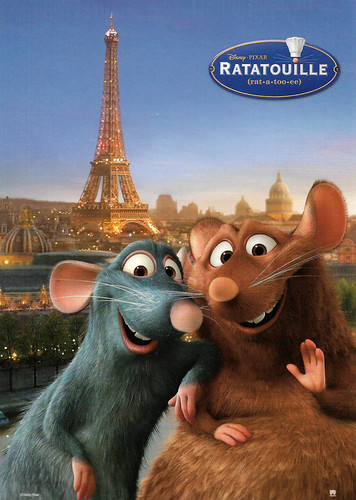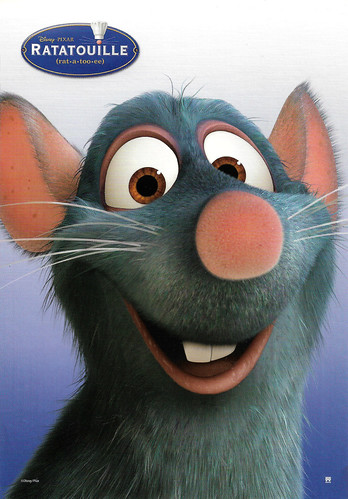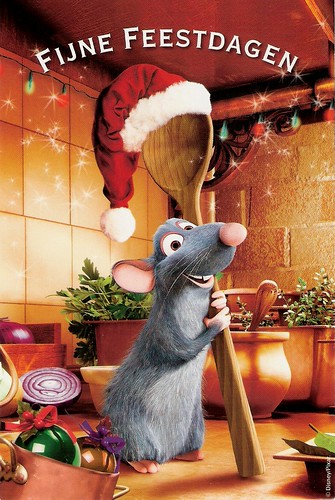
French postcard by Sonis, no. C. 1789. Image: Disney / Pixar. Remy and Emile in Ratatouille (Brad Bird, Jan Pinkava, 2007).

French postcard by Sonis, no. C. 1790. Image: Disney / Pixar. Linguini and Remy in Ratatouille (Brad Bird, Jan Pinkava, 2007).
A rat called Remy
Ratatouille (Brad Bird, Jan Pinkava, 2007) tells the story of a rat called Remy. Remy has a gift for flavours and dreams of becoming a great French chef. However, his family does not like this and sees eating as a way to survive.
Moreover, people in the cooking world do not really like rats either. When the rat colony has to flee after being discovered by the owner of the house they were staying in, Remy gets separated from his family and ends up in the sewers of Paris.
He ends up in the restaurant of his idol, the cook Auguste Gusteau. However, Auguste appears to have died, but in Remy's imagination, his spirit regularly appears to assist him. At the same time, a young man named Alfredo Linguini arrives at the restaurant with a letter written by his deceased mother, an old friend of Gusteau's. The new restaurant owner Skinner is therefore forced to hire Linguini.
Linguini, however, turns out to have no talent at all for cooking. Remy sees how Linguini desperately tries to cook soup and fails, and intervenes. Linguini catches Remy and catches him but keeps him hidden from Skinner. Before anyone can do anything, the soup is served and proves a success. The kitchen staff think that Linguini made the soup and Colette, the restaurant's only female cook, convinces Skinner to let him stay.
Skinner agrees, but Colette must train him herself. Remy tries to escape and is spotted by Skinner. He orders Linguini to take the rat and kill it, as a rat in their restaurant would be a disaster for their reputation.

French postcard by Sonis, no. C. 1791. Image: Disney / Pixar. Film Images for Ratatouille (Brad Bird, Jan Pinkava, 2007).

French postcard by Sonis, no. C. 1792. Image: Disney / Pixar. Remy in Ratatouille (Brad Bird, Jan Pinkava, 2007).
So that illustrators could see how his suit would react
The idea for Ratatouille (Brad Bird, Jan Pinkava, 2007) came from Jan Pinkava. He came up with the characters and the broad outlines of the story. However, Pixar had little faith in Pinkava's development of the script, so Brad Bird was put in charge.
Bird made a few major changes. He made the rats less anthropomorphic. In the original screenplay, Gusteau was still alive, but Bird concluded there were too many stories to tell and decided Gusteau would be dead. However, he does still speak to Remy as his "conscience". Brad Bird also put a lot of slapstick humour in the film, especially with the character Linguini.
Brad Bird and his team spent a week in Paris drawing pictures and getting inspiration for the film. The animation brought some new challenges. There were water scenes, for example, which the illustrators said were more difficult than those in Finding Nemo (Andrew Stanton, Lee Unkrich, 2003). For the scene where Linguini jumps into the river to catch Remy, a Pixar employee dressed in a chef's uniform jumped into a swimming pool so that illustrators could see how his suit would react.
Pet rats were kept at the studio in the hallway for more than a year so that the animators could study the movement of their fur, noses, ears, paws, and tails. The trickiest part was drawing the food digitally. This had to look realistic and tasty for the film. For this, the artists sought advice from both American and French chefs and attended a cooking course. The animation team worked alongside chef Thomas Keller at his restaurant French Laundry in order to learn the art of cooking. Mr. Keller also appears in a cameo role as the voice of a patron at Gusteau's.
Brad Bird collaborated with Michael Giacchino on the music for Ratatouille. The two previously worked on the film music for The Incredibles (Brad Bird, 2004). Giacchino wrote two songs, especially for the character Remy; one about his life as a rat and one about his dreams of becoming a chef. He also wrote the title song for the film, 'Le Festin'. This song is sung by Camille and can be heard in French in all versions of the film.

French postcard by Sonis, no. C. 1794. Image: Disney / Pixar. Film images for Ratatouille (Brad Bird, Jan Pinkava, 2007).

French postcard by Sonis, no. C. 1795. Image: Disney / Pixar. Remy in Ratatouille (Brad Bird, Jan Pinkava, 2007).
Pleasurably tickling the senses of audience members of any age
Critics' reactions to Ratatouille (Brad Bird, Jan Pinkava, 2007) were almost exclusively positive. Perry Seibert at AllMovie: "Artistically employing state-of-the-art CG animation, director Brad Bird uses colorful imagery to create a visual metaphor for what this rat with a highly refined palette experiences whenever he eats good food.
The bright, playful splashes of color that symbolize Remy's exploding taste buds have the same effect for the audience as they do for the rat, pleasurably tickling the senses of audience members of any age. If Ratatouille accomplished nothing else, it would still be a very good movie, but the film goes even further.
Remy is such a likeable, sympathetic character that his story translates to anyone's calling or interest, from cooking to filmmaking to sculpture. Without a doubt, Ratatouille is a heartwarming story, but its subtext expresses why art matters so deeply to those who make it, as well as to those who appreciate it."
The film brought in $47 million in its opening weekend. In the United States, this was the lowest opening for a Pixar film since A Bug's Life (John Lasseter, 1998). However, in France, where the film's story is set, the film broke all attendance records for an animated film.
When the film disappeared from cinemas again, the total worldwide revenue was $624,445,654, making Ratatouille the third-best Pixar film at the box office ever. Ratatouille had a sequel in the form of the short film Your Friend the Rat, which can be found on the DVD.

Dutch postcard. Image: Disney / Pixar. Remy in Ratatouille (Brad Bird, Jan Pinkava, 2007). Caption: Happy holidays.
Sources: Perry Seibert (AllMovie), Wikipedia (Dutch), and IMDb.
No comments:
Post a Comment